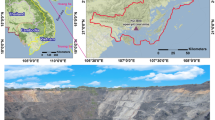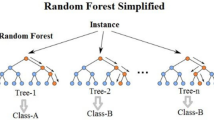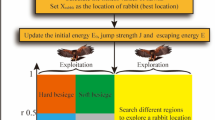Abstract
Blasting is one of the primary mining operations for extracting minerals and ores however, if not designed properly, may have a varying degree of environmental and socio-economic impact in and around mining areas. In Indian mining industry, blast designs are fundamentally based on the experience and capability of the blasting crew and its assessment is more qualitative in nature, based on conventional trial and error basis. With the change in site geology and geotechnical parameters, the blast design parameters also require alterations, which can be standardized with the development of an intelligent system such as neural network. In this paper, the concept of artificial neural network and random forest algorithm has been used for better blast designs. Over 120 blast results from an opencast coal mine have been used for prediction of burden and energy factor with blast hole diameter, bench height to stemming ratio, nature of strata and average fragment size as input parameters. Out of 120 data sets 85 data sets recorded at a surface coal mine was used to train the model and 20 for the validation. Co-efficient of determination and root mean square error was chosen as the indicators to identify the optimum neural network and random forest model. The root mean square values obtained for energy factor is 0.153 while it is 0.1947 for burden. Similarly, the RMSE values obtained using random forest tree algorithm is 0.48 for burden while 50.76 for energy factor. The results revealed that random forest tree network system has potential to design better blast that is not generic and can be a potential tool for blasting engineers to design optimum blast for the mines.











Similar content being viewed by others
References
Bagde MN, Raina AK, Chakraborty AK, Jethwa JL (2002) Rock mass characterization by fractal dimension. Eng Geol 63(1):141–155
Bauer A (1982) Wall control blasting in open pits. In: Proceedings of the 14th Canadian rock mechanics symposium, Vancouver, British Columbia, Canada, May 3–10
Cai JG, Zhao J (1997) Use of neural networks in rock tunneling. In: Proceedings of the international conference on computer methods and advances in geomechanics, pp 613–618
Chakraborty AK, Raina AK, Ramulu M, Choudhury PB, Haldar A, Sahu P, Bandopadhyay C (2004) Parametric study to develop guidelines for blast fragmentation improvement in jointed and massive formations. Eng Geol 73(1):105–116
Cheng MY, Ko CH (2006) A genetic-fuzzy-neuro model encodes FNNs using SWRM and BRM. Eng Appl Artif Intell 19(8):891–903
Chimankar R (2002) Development of intelligent software for tunnel blast design using artificial neural network. M.Tech thesis, Indian School of Mines, Dhanbad (unpublished)
Cunningham CVB (1996) Optical fragmentation assessment—a technical challenge. In: Franklin JA, Katsabanis T (eds) Measurement of blast fragmentation. Balkema, Rotterdam, pp 13–19
Fairhurst C (1964) On the validity of the ‘Brazilian’ test for brittle materials. Int J Rock Mech Min Sci Geomech Abstr 1(4):535–546 (Pergamon)
Feng X (1995) A neural network approach to comprehensive classification of rock stability, blastability and drillability. Int J Surf Min Reclam 9(2):57–62
Franklin JA (1971) Triaxial strength of rock materials. Rock Mech 3(2):86–98
Jade R (1998) Model free estimation of optimum burden in production blasts: a neural network approach. M.Tech thesis, Indian School of Mines, Dhanbad (unpublished)
Jong YH, Lee CI (2004) Influence of geological conditions on the powder factor for tunnel blasting. Int J Rock Mech Min Sci 41:533–538
Khandelwal M (2002) Application of neural network for the prediction of triaxlal constants from uniaxial compressive strength. M.Tech thesis, Departmentt of Mining Engineering, Banaras Hindu University, Varanasi, India (unpublished)
Khandelwal M, Singh TN (2002) Prediction of waste dump stability by an intelligent approach. In: National symposium new equipment—new technology, management and safety, pp 38–45
Khandelwal M, Singh TN (2005) Prediction of blast induced air overpressure in opencast mine. Noise Vib Worldw 36(2):7–16
Khandelwal M, Singh TN (2006) Prediction of blast induced ground vibrations and frequency in opencast mine: a neural network approach. J Sound Vib 289(4):711–725
Khandelwal M, Singh TN (2007) Evaluation of blast-induced ground vibration predictors. Soil Dyn Earthq Eng 27(2):116–125
Khandelwal M, Singh TN (2009) Prediction of blast-induced ground vibration using artificial neural network. Int J Rock Mech Min Sci 46(7):1214–1222
Kosko B (1992) Neural networks and fuzzy systems: a dynamical systems approach to machine intelligence/book and disk, vol 1. Prentice Hall, Upper Saddle River
Kulatilake PH, Qiong W, Hudaverdi T, Kuzu C (2010) Mean particle size prediction in rock blast fragmentation using neural networks. Eng Geol 114(3):298–311
Kumar N, Sen P (2001) A neural network approach to waste dump analysis and design. J Mines Met Fuels 49:129–135
Liu Y, Wang J (1999) A neural network method for engineering rock mass classification. In: 9th ISRM congress, international society for rock mechanics
Lu Y (2005) Underground blast induced ground shock and its modelling using artificial neural network. Comput Geotech 32(3):164–178
MathWorks Inc (2009) Neural networks toolbox for use with MATLAB. User’s guide version 7.8. The MathWorks Inc, Natick
Monjezi M, Rezaei M, Yazdian A (2010) Prediction of backbreak in open-pit blasting using fuzzy set theory. Expert Syst Appl 37(3):2637–2643
Monjezi M, Ghafurikalajahi M, Bahrami A (2011) Prediction of blast-induced ground vibration using artificial neural networks. Tunn Undergr Space Technol 26(1):46–50
Pal Roy P, Sawmliana C, Bhagat NK, Madhu M (2003) Induced caving by blasting: innovative experiments in blasting gallery panels of underground coal mines of India. Min Technol 112(1):57–63
Rafiai H, Jafari A (2011) Artificial neural networks as a basis for new generation of rock failure criteria. Int J Rock Mech Min Sci 48(7):1153–1159
Rai P, Baghel SS (2004) Investigation of firing patterns on fragmentation in an Indian opencast limestone mine. Quarry Manag 31(2):33–38
Rai P, Ranjan AK, Singh B (2005) Optimizing fragmentation—investigation of stiffness ratio on fragmentation in moderately hard sandstone strata. Quarry Manag 33–37
Rai P, Ranjan AK, Choudhary BS (2008) Achieving effective fragmentation. Quarry Manag 17–19
Rai P, Yang HS, Choudhary BS (2012) Formation of slot cut for creating free face in solid limestone bench: a case study. Powder Technol 228:327–333
Raina AK, Choudhary PB, Ramulu M, Chakraborty AK, Dudhankar AS, Udpikar V, Ghatpande N, Misra DD (2002) Fragalyst—an indigenous digital image analysis system for grain size measurements in mines. Geol Soc India 59(6):561–569
Raina AK, Ramulu M, Choudhury PB, Chakraborty AK, Sinha A, Ramesh-Kumar B, Fazal M (2010) Productivity improvement in an opencast coal mine in India using digital image analysis technique. In: Fragmentation by blasting, proceedings of the 9th international symposium on rock fragmentation by blasting—Fragblast, vol 9, pp 13–17
Ramamurthy T, Rao GV, Rao K (1985) A strength criterion for rocks. In: Proceedings of the Indian geotechnical conference, Roorkee, India, pp 59–64
Ramulu M, Chakraborty A, Raina A, Dudhankar A, Choudhury P, Jethwa JL (2001) Application of digital image analysis technique for fragmentation assessment and blast optimisation. In: Proceedings of the annual conference on explosives and blasting technique, vol 1, pp 273–284
Rodriguez-Galianoa V, Sanchez Castillo M, Chica Olmo M, Chica Rivas M (2015) Machine learning predictive models for mineral prospectivity: an evaluation of neural networks, random forest, regression trees and support vector machines. Ore Geol Rev 71:804–818
Rout M (2014) An investigation into the influence of various properties of emulsion explosives on velocity of detonation. PhD thesis, Department of Mining Engineering, Indian School of Mines, Dhanbad (unpublished)
Rzhevsky VV (1985) Opencast mining: unit operations. Mir Publishers, Moscow
Sarathy MO (2000) Optimum blasting in surface mines—major issues. In: Proceedings of the seminar on blasting objectives and risk management, Hyderabad, pp 13–14
Sayadi A, Monjezi M, Talebi N, Khandelwal M (2013) A comparative study on the application of various artificial neural networks to simultaneous prediction of rock fragmentation and backbreak. J Rock Mech Geotech Eng 5(4):318–324
Scoble MJ, Lizotte YC, Paventi M, Mohanty BB (1996) Measurement of blast damage. In: Proceedings of the SME annual meeting, pp 96–103
Sheorey PR (1997) Empirical rock failure criteria. AA Balkema, Amsterdam
Singh VK, Singh D, Singh TN (2001) Prediction of strength properties of some schistose rocks from petrographic properties using artificial neural networks. Int J Rock Mech Min Sci 38(2):269–284
Singh S, VanDoorselaere D, Narendrula R (2006) A comparison between sieved, predicted and measured blast fragmentation results. In: proceedings of the annual conference on explosives and blasting technique, vol 32, no 2, p 265
Sirat M, Talbot CJ (2001) Application of artificial neural networks to fracture analysis at the Äspö HRL, Sweden: fracture sets classification. Int J Rock Mech Min Sci 38(5):621–639
Sumathi S, Paneerselvam S (2010) Computational intelligence paradigms: theory& applications using MATLAB, 1st edn. CRC Press, Boca Raton, pp 85–86
Wang J, Milne D, Pakalnis R (2002) Application of a neural network in the empirical design of underground excavation spans. Min Technol 111(1):73–81
Yang HS, Rai P (2011) Characterization of fragment size vis-à-vis delay timing in quarry blasts. Powder Technol 211(1):120–126
Yang Y, Zhang Q (1997a) Analysis for the results of point load testing with artificial neural network. In: Proceedings of the international conference on computer methods and advances in geomechanics, pp 607–612
Yang Y, Zhang Q (1997b) A hierarchical analysis for rock engineering using artificial neural networks. Rock Mech Rock Eng 30(4):207–222
Yoshida N, Morgenstern NR, Chan DH (1990) A failure criterion for stiff soils and rocks exhibiting softening. Can Geotech J 27(2):195–202
Youssef AM, Pourghasemi HR, Pourtaghi ZS, Al-Katheeri MM (2016) Landslide susceptibility mapping using random forest, boosted regression tree, classification and regression tree, and general linear models and comparison of their performance at Wadi Tayyah Basin, Asir Region, Saudi Arabia. Landslides 13(5):839–856
Zhang Q, Song J, Nie X (1991) Application of neural network models to rock mechanics and rock engineering. Int J Rock Mech Min Sci Geomech Abstr 28(6):535–540 (Pergamon)
Author information
Authors and Affiliations
Corresponding author
Rights and permissions
About this article
Cite this article
Mishra, A.K., Ramteke, S.V., Sen, P. et al. Random Forest Tree Based Approach for Blast Design in Surface Mine. Geotech Geol Eng 36, 1647–1664 (2018). https://doi.org/10.1007/s10706-017-0420-8
Received:
Accepted:
Published:
Issue Date:
DOI: https://doi.org/10.1007/s10706-017-0420-8




